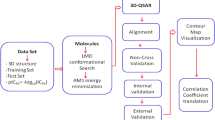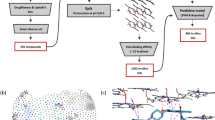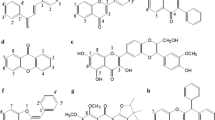Abstract
Plasmodium falciparum glucose-6-phosphate dehydrogenase (PfG6PD) has been considered as a potential target for severe forms of anti-malaria therapy. In this study, several classification models were built to distinguish active and weakly active PfG6PD inhibitors by support vector machine method. Each molecule was initially represented by 1,044 molecular descriptors calculated by ADRIANA.Code. Correlation analysis and attribute selection methods in Weka were used to get the best reduced set of molecular descriptors, respectively. The best model (Model 2w) gave a prediction accuracy (Q) of 93.88 % and a Matthew’s correlation coefficient (MCC) of 0.88 on the test set. Some properties such as \(\sigma \) atom charge, \(\pi \) atom charge, and lone pair electronegativity-related descriptors are important for the interaction between the PfG6PD and the inhibitor.




Similar content being viewed by others
References
Jortzik E, Mailu BM, Preuss J, Fischer M, Bode L, Rahlfs S, Becker K (2011) Glucose-6-phosphate dehydrogenase-6-phosphogluconolactonase: a unique bifunctional enzyme from Plasmodium falciparum. Biochem J 436:641–650. doi:10.1042/BJ20110170
Hayden T (2006) Making inroads on malaria. Anal Chem 78:5252–5260. doi:10.1021/ac069431b
Preuss J, Maloney P, Peddibhotla S, Hedrick MP, Hershberger P, Gosalia P, Milewski M, Li YL, Sugarman E, Hood B, Suyama E, Nguyen K, Vasile S, Sergienko E, Mangravita-Novo A, Vicchiarelli M, McAnally D, Smith LH, Roth GP, Diwan J, Chung TD, Jortzik E, Rahlfs S, Becker K, Pinkerton AB, Bode L (2012) Discovery of a Plasmodium falciparum glucose-6-phosphate dehydrogenase 6-phosphogluconolactonase inhibitor (R,Z)-N-((1-ethylpyrrolidin-2-yl)methyl)-2-(2-fluorobenzylidene)-3-oxo-3,4-dihydro-2H-benzo[b][1,4]thiazine-6-carboxamide (ML276) that reduces parasite growth in vitro. J Med Chem 55:7262–7272. doi:10.1021/jm300833h
Qidwai T, Jamal F (2012) Glucose-6-phosphate dehydrogenase deficiency by methylation mediated gene silencing provides resistance against falciparum malaria. Int J Pharm Bio Sci 3:284–292
NCBI. http://www.ncbi.nlm.nih.gov/pcassay/. Accessed March 2013
Gupte RS, Ata H, Rawat D, Abe M, Taylor MS, Ochi R, Gupte SA (2011) Glucose-6-phosphate dehydrogenase is a regulator of vascular smooth muscle contraction. Antioxid Redox Signal 14:543–558. doi:10.1089/ars.2010.3207
Murambiwa P, Masola B, Govender T, Mukaratirwa S, Musabayane CT (2011) Anti-malarial drug formulations and novel delivery systems: a review. Acta Trop 118:71–79. doi:10.1016/j.actatropica.2011.03.005
Olliaro PL, Taylor WR (2004) Developing artemisinin based drug combinations for the treatment of drug resistant falciparum malaria: a review. J Postgrad Med 50:40–44
PubChem. http://pubchem.ncbi.nlm.nih.gov/assay/assay.cgi?aid=540269. Accessed March 2013
Wang K, Hu X, Wang Z, Yan A (2012) Classification of acetylcholinesterase inhibitors and decoys by a support vector machine. Comb Chem High Throughput Screen 15:492–502. doi:10.2174/138620712800563891
Burbidge R, Trotter M, Buxton B, Holden S (2001) Drug design by machine learning: support vector machines for pharmaceutical data analysis. Comput Chem 26:5–14. doi:10.1016/S0097-8485(01)00094-8
Yan A, Chong Y, Wang L, Hu X, Wang K (2011) Prediction of biological activity of aurora-a kinase inhibitors by multilinear regression analysis and support vector machine. Bioorg Med Chem Lett 21:2238–2243. doi:10.1016/j.bmcl.2011.02.110
Cortes C, Vapnik V (1995) Support-vector networks. Mach Learn 20:273–297. doi:10.1007/BF00994018
Fernandez M, Caballero J, Fernandez L, Sarai A (2011) Genetic algorithm optimization in drug design QSAR: Bayesian-regularized genetic neural networks (BRGNN) and genetic algorithm-optimized support vectors machines (GA-SVM). Mol Divers 15:269–289. doi:10.1007/s11030-010-9234-9
Fernandez M, Caballero J, Fernandez L, Abreu JI, Acosta G (2008) Classification of conformational stability of protein mutants from 3D pseudo-folding graph representation of protein sequences using support vector machines. Proteins 70:167–175. doi:10.1002/prot.21524
Fernandez M, Caballero J, Fernandez L, Abreu JI, Acosta G (2007) Classification of conformational stability of protein mutants from 2D graph representation of protein sequences using support vector machines. Mol Simul 33:889–896. doi:10.1080/08927020701377070
Fernandez M, Fernandez L, Sanchez P, Caballero J, Acosta G (2008) Proteometric modelling of protein conformational stability using amino acid sequence autocorrelation vectors and genetic algorithm-optimised support vector machines. Mol Simul 34:857–872. doi:10.1080/08927020802301920
Dong X, Jiang C, Hu H, Yan J, Chen J, Hu Y (2009) QSAR study of Akt/protein kinase B (PKB) inhibitors using support vector machine. Eur J Med Chem 44:4090–4097. doi:10.1016/j.ejmech.2009.04.050
Yan A, Nie X, Wang K, Wang M (2013) Classification of aurora kinase inhibitors by self-organizing map (SOM) and support vector machine (SVM). Eur J Med Chem 61:73–83. doi:10.1016/j.ejmech.2012.06.037
Tobita M, Nishikawa T, Nagashima R (2005) A discriminant model constructed by the support vector machine method for HERG potassium channel inhibitors. Bioorg Med Chem Lett 15:2886–2890. doi:10.1016/j.bmcl.2005.03.080
Xuan S, Wu Y, Chen X, Liu J, Yan A (2013) Prediction of bioactivity of HIV-1 integrase ST inhibitors by multilinear regression analysis and support vector machine. Bioorg Med Chem Lett 23:1648–1655. doi:10.1016/j.bmcl.2013.01.081
Darnag R, Schmitzer A, Belmiloud Y, Villemin D, Jarid A, Chait A, Seyagh M, Cherqaoui D (2009) QSAR studies of HEPT derivatives using support vector machines. QSAR Comb Sci 28:709–718. doi:10.1002/qsar.200810166
Yao XJ, Panaye A, Doucet JP, Zhang RS, Chen HF, Liu MC, Hu ZD, Fan BT (2004) Comparative study of QSAR/QSPR correlations using support vector machines, radial basis function neural networks, and multiple linear regression. J Chem Inf Comput Sci 44:1257–1266. doi:10.1021/ci049965i
ADRIANA. Code, Molecular Networks GmbH, Erlangen, Germany. http://www.molecular-networks.com/. Accessed March 2013
Weka, Version 3.61. The University of Waikato Hamilton, New Zealand. http://www.cs.waikato.ac.nz/ml/weka/. Accessed March 2013
Kohonen T (1982) Self-organized formation of topologically correct feature maps. Biol Cybern 43:59–68. doi:10.1007/BF00337288
CORINA, version 3.2, Molecular Networks GmbH, Erlangen, Germany. http://www.molecular-networks.com/. Accessed March 2013
Lipinski CA, Lombardo F, Dominy BW, Feeney PJ (2001) Experimental and computational approaches to estimate solubility and permeability in drug discovery and development settings. Adv Drug Deliv Rev 46:3–26. doi:10.1016/S0169-409X(00)00129-0
Ertl P, Rohde B, Selzer P (2000) Fast calculation of molecular polar surface area as a sum of fragment-based contributions and its application to the prediction of drug transport properties. J Med Chem 43:3714–3717. doi:10.1021/jm000942e
Miller KJ (1990) Additivity methods in molecular polarizability. J Am Chem Soc 112:8533–8542. doi:10.1021/ja00179a044
Hemmer MC, Steinhauer V, Gasteiger J (1999) Deriving the 3D structure of organic molecules from their infrared spectra. Vib Spectrosc 19:151–164. doi:10.1016/S0924-2031(99)00014-4
Yan A, Gasteiger J (2003) Prediction of aqueous solubility of organic compounds based on a 3D structure representation. J Chem Inf Comput Sci 43:429–434. doi:10.1021/ci025590u
Chang C-C, Lin C-J (2011) LIBSVM: a library for support vector machines. ACM Trans Intell Syst Technol 2:1–39. doi:10.1145/1961189.1961199
Dogra SK. “Y Scrmabling” From QSAR World—A Strand Life Sciences Web Resource. http://www.qsarworld.com/qsar-statistics-y-scrambling.php/. Accessed March 2013
Yan A (2006) Modeling of Gibbs energy of formation of organic compounds by linear and nonlinear methods. J Chem Inf Model 46:2299–2304. doi:10.1021/ci0600105
Ma SG, Dai Y (2011) Principal component analysis based methods in bioinformatics studies. Brief Bioinform 12:714–722. doi:10.1093/bib/bbq090
Acknowledgments
This study was supported by the National Natural Science Foundation of China (20975011) and “Chemical Grid Project” of Beijing University of Chemical Technology. We thank Molecular Networks GmbH, Erlangen, Germany for making the programs ADRIANA.Code, Corina, and SONNIA available for our work.
Author information
Authors and Affiliations
Corresponding author
Electronic supplementary material
Below is the link to the electronic supplementary material.
Rights and permissions
About this article
Cite this article
Hou, X., Yan, A. Classification of Plasmodium falciparum glucose-6-phosphate dehydrogenase inhibitors by support vector machine. Mol Divers 17, 489–497 (2013). https://doi.org/10.1007/s11030-013-9447-9
Received:
Accepted:
Published:
Issue Date:
DOI: https://doi.org/10.1007/s11030-013-9447-9




